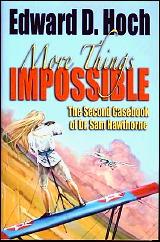Mon 21 Dec 2009
Three More by EDWARD D. HOCH – The Christmas Edition, by Mike Tooney.
Posted by Steve under Reviews[11] Comments
by Mike Tooney:
For Part Three of this series, go here.

10. “The Problem of the Christmas Steeple.” Ellery Queen’s Mystery Magazine, January 1977. Reprinted in Diagnosis: Impossible: The Problems of Dr. Sam Hawthorne , by Edward D. Hoch. Crippen & Landru, hardcover/trade paperback, 1996.
Comments: It’s December 1925, and a minister has been murdered in the steeple of his own church, a place from which no one could escape unseen — and the only other person, a gypsy, who was there, swears he didn’t do it.
Even Sheriff Lens, not normally quick on the uptake, suspects there’s more to this than first meets the eye: “Some said he was runnin’ a giant con game, while others thought he was more interested in the parish wives. Whatever the truth, his background was mighty shady.”
All of this sets Dr. Sam Hawthorne to wondering: “How could you have a locked room that wasn’t even a room — that was in fact open on all four sides? And how could you have a mystery when the obvious murderer was found right there with the weapon and the body?”

11. “The Problem of Santa’s Lighthouse.” Ellery Queen’s Mystery Magazine, December 1983. Reprinted in More Things Impossible: The Second Casebook of Dr. Sam Hawthorne, by Edward D. Hoch. Crippen & Landru, hardcover/trade paperback, 2006.
Comments: It’s Christmas 1931, but even a place celebrating peace on earth is not immune from violence. Visiting a lighthouse that has been converted to catch the seasonal trade, Dr. Sam Hawthorne witnesses — or almost witnesses — an impossible crime: “I looked up in in time to see a figure falling from the circular walkway at the top of the lighthouse …. Then I saw the handle of the dagger protruding from between his ribs and I knew that help was useless.”
But Dr. Sam never sees the perpetrator, even though it should have been possible. How can it be that someone on one end of a building could stab somebody else on the other end without being seen?
To complicate matters further, Sam runs afoul of a murderous gang anxious to protect a secret: “We made it halfway down the stairs before they caught us, and I tripped and stumbled the rest of the way to the ground floor, landing hard on my chest. I looked up and saw one of the men take out a knife ….”
If you remember your American history, you could surmise what that secret might be. (Hint: the 18th Amendment to the U. S. Constitution.)

12. “Christmas Is for Cops.” Ellery Queen’s Mystery Magazine, December 1970. Reprinted in Murder for Christmas, edited by Thomas Godfrey. Mysterious Press, hardcover, 1982.
“Is he dead, Captain?”
“As dead as he’ll ever be. What a mess!”
“You think one of our men did it?”
“Who else?”
Comments: It’s Christmas in Captain Leopold’s precinct, and a convivial party for all the policemen is in the offing.
It’s Leopold’s unhappy duty, however, to deal with one of his own men, a cop on the take. The evidence is incontrovertible, and the Captain is about to turn him over to the DA when the crooked cop begs him for more time. He admits his wrongdoing to Leopold but also claims he has an audio recording that will nail another cop in his unit who is also on the take. Reluctantly, the Captain grants the request.
The next evening, at the Christmas party, the fun is interrupted by the discovery of Leopold’s would-be informant, stabbed to death. The Captain is neck-deep in suspects now — over sixty cops plus their wives.
There’s also that unresolved matter of the recording. Leopold has reason to believe that, if it even exists, it’s either under or hidden somewhere on the big twenty-foot Christmas tree — but a careful search yields nothing.
And then there’s that piece of crime scene evidence that points the finger of guilt at the wife of his trustworthy subordinate, Lieutenant Fletcher.
Captain Leopold must untangle all these contradictions, or this Christmas won’t be merry at all.
December 22nd, 2009 at 7:44 am
I’ve already said (elsewhere, probably) that Dr. Sam Hawthorne is my favorite of Hoch’s series characters. The combination of the impossible crime and the period setting is unbeatable.
The man had a wonderful imagination.
December 22nd, 2009 at 11:40 am
I prefer Simon Ark and Nick Velvet, but the Hawthorne stories are good. Though not in a class with the shorts, the sf/mysteries Hoch did were good too. Considering he did a story for EQMM and AHMM each almost every month — and quite a few for The Saint, his career is amazing.
Recently there was some question here who was king of the pulps or the paperbacks, but Hoch is the undisputed king of the mystery digests.
December 22nd, 2009 at 5:14 pm
In the letter column for M*F 46, Marv Lachman suggested the late Barry Sullivan as the ideal actor to play Nick Velvet. I countered with my own choice of Timothy Dalton.
I don’t know who to suggest to play Dr. Hawthorne. I don’t have more than a generic picture of him in my mind, I’m afraid. Perhaps I should read one of his stories more recently than I have. As for Simon Ark … ????
December 22nd, 2009 at 5:47 pm
I always saw Peter Cushing or Christopher Lee as Ark. Not sure if I had a specific actor for Hawthorne, though all those years of William Windom as the New England doctor on Murder She Wrote may have colored my vision.
I like either Sullivan or Dalton for Nick Velvet, though I have to say in my minds eye I always thought of a younger Robert Loggia, only because Nick seemed to have something in common with his character in T.H.E. Cat. On the other hand I always had Richard Todd and Dana Wynter in mind for Rand and his wife.
That said Hoch’s characters are so real that the picture in my minds eye isn’t an actor, but a sort of image drawn from Hoch’s writing about them. One of those situations where you feel you would know them if you met them.
December 22nd, 2009 at 6:53 pm
I still like my suggestion of Timothy Dalton, but that’s who I picked around the time of the interview, which was some five years ago. But would you believe that when I left that comment above — just a few minutes ago — I almost changed my mind to say Robert Loggia?
It must be the T.H.E.CAT connection, but then again, Loggia was perfect in the part.
My own choice for Simon Ark would be Ray Milland. Maybe Cushing or Lee would be better, but I somehow think Milland would play him with just the right kind of mysteriousness about him.
I’m still puzzled about Sam Hawthorne, though, and I think your last paragraph about him puts a finger on exactly why.
— Steve
December 23rd, 2009 at 12:08 am
Ray Milland as Ark — certainly if he played it along the lines of his role in Alias Nick Beal. Can’t be much more mysterious than that.
Loggia did get to play at least one series character. He was Steve Carella (called Carelli in the film for no real reason) in Cop Hater, not a bad little adaptation of the Mcbain novel, with Jerry Orbach showing up in one scene as a juvenile delinquent, and Vincent Gardenia in another as a junkie informer.
December 23rd, 2009 at 7:23 am
I think Cushing would have made a great Ark.
December 23rd, 2009 at 1:25 pm
Ben Kingsley as Ark.
Who would play another of my favorite Hoch characters, Ben Snow? In my mind’s eye, it would be a non-grinning Simon Baker. How far off am I?
And how about Ed O’Neill for Captain Leopold?
December 23rd, 2009 at 10:13 pm
I always saw Hershel Bernardi as Leopold, but it may just be because of his Lt. Jacobi on Peter Gunn. Oddly the other face that comes to mind is Victor Jory. Again the influence of old television shows.
As for Ben Snow I can’t quite see the English Baker in the role (though he plays an American perfectly well). I always see him as one of those world weary gunfighter characters from fifties westerns played by the likes of John Payne,Rory Calhoun, Barry Sullivan, or even Robert Taylor.
But re Simon Ark, considering the back story is that he may be 2000 years old I suppose we are all remiss for not thinking of Mel Brooks in the role — the original 2000 Year Old Man.
But I’ll throw in an odd one. The first time I read one of the Sebastian Blue stories I had Patrick O’Neal in mind.
Still, I hold with what I said earlier, actors to one side, I think I’d know most of Hoch’s characters if I saw them. And considering we know them exclusively from short stories and he seldom describes them that’s quite an achievement.
December 24th, 2009 at 1:13 am
These Dr. Sam stories are the best modern classical stories I have read. I hope Crippen and Landru eventually release them all.
January 6th, 2011 at 12:11 pm
[…] For Part Four of this series, go here. […]